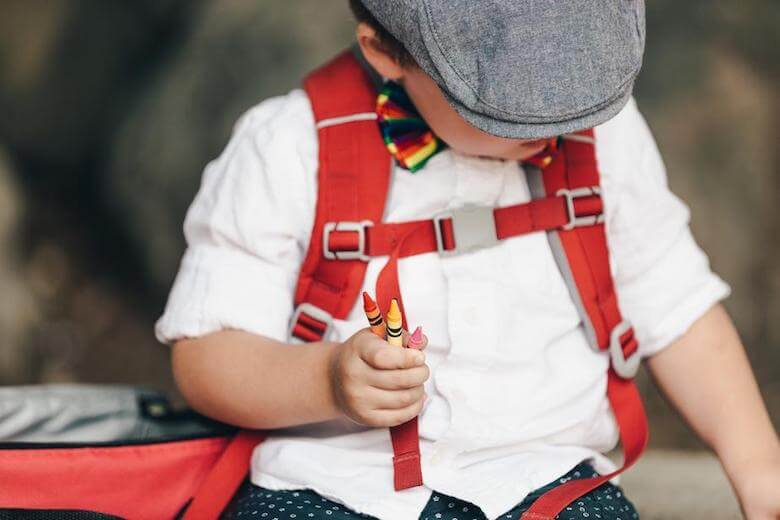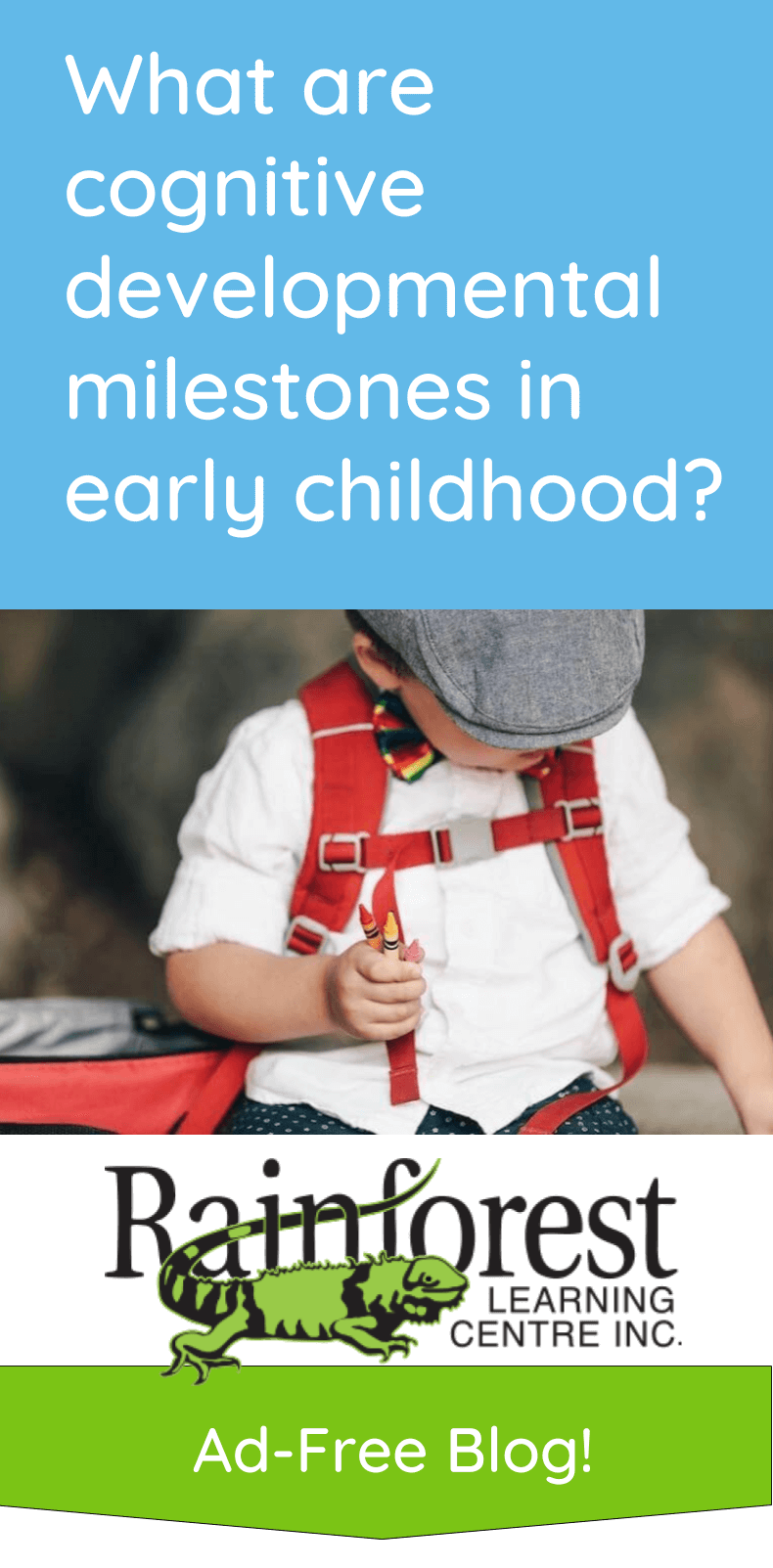
There are many lists that describe what a child should be able to do or understand at infancy, as a toddler or as a preschooler, and so on. Many of these are based on Jean Piaget’s research. Piaget was a psychologist in Switzerland. The cognitive development stages he proposed reach up to adulthood, and sometimes overlap with each other. Taken from Wikipedia, they are:
- Sensorimotor stage (ages 0 – 2)
- Simple reflexes (birth to 6 weeks)
- First habits and primary circular reactions phase (6 weeks – 4 months)
- Secondary circular reactions phase (4–8 months)
- Coordination of secondary circular reactions stages (8–12 months)
- Tertiary circular reactions, novelty, and curiosity (12–18 months)
- Internalization of schemas (18–24 months)
- Preoperational stage (ages 2 – 7)
- Symbolic function (ages 2 – 4)
- Intuitive thought (ages 4 – 7)
- Concrete operational stage (ages 7 – 11)
- Formal operational stage (ages 11 – 20)
In this article, we’ll give you examples of normal cognitive development that lead up around 5 years old, covering early childhood. We’ll use segments of age that may not correspond to Piaget’s, but that can still help you gauge what is ‘normal.’ Many of these examples still fit with Piaget’s theory.
Remember that what we present below are just examples. If your child does or does not ‘hit’ all of these points at each age, that is not to say they are healthy or unhealthy. We still encourage you to research other information, and speak to your doctor (especially if you think something is wrong).
Between birth to 3 months your child should:
- Suck their thumb or a nipple.
- Follow faces or objects that are not static with their eyes.
- Recognize sound differences. E.g. you might notice a different look on their face when they hear adults making baby noises at them.
- Grab your finger or grasp other objects they can old (like sheets or blankets).
Between 3 to 6 months your child should:
- Show interest in holding objects, and try to reach for them, or put them in their mouth.
- Recognize faces.
- React to sounds and faces by making their own sounds and faces. E.g. giggles if they hear a new noise, or a noise they like.
- Get fidgety and want to move around or change position.
At 6 to 9 months your child should:
- Recognize that a toy has disappeared suddenly and wonder what happened. E.g. if they drop it on the floor from their high chair and can’t see it anymore. Or if playing peek-a-boo.
- Understand how some toys work. E.g. if they have buttons to push, they push them. If they are for shaking to make noises, they shake them.
- Realize that some objects are beyond their reach. E.g. staring at mobiles or ceiling lights that are too far to reach for.
Between 9 to 12 months your child should:
- Know that objects they can’t see are still there. E.g. you hide the rattle behind your back and they anticipate that it’s still there. Or you take their soother away and they know you have it.
- Copy you, or respond on command to a game they know. E.g. Giving you a ‘high five.’
- Experiment to solve problems, or try to repeat their experiments. E.g. ‘how do I make this toy do that?’ Or, ‘let’s drop our food on the floor again to watch it fall.’ And yes, they should succeed, eventually!
- Match things or concepts together. E.g. they know that “moo” is for cow and that a cylinder goes in the circle hole.
At 12 to 18 months (1 to 1.5 years) old your child should:
- Hold and attempt to manipulate objects. E.g. put toys in a bucket, or knock down blocks on purpose.
- Recognize objects by pointing to them when asked.
- Follow routines. E.g. they run to their home apartment door and seem to know which one it is. Or they know that ‘milk’ means nap time.
- Can respond to simple instructions. E.g. “Let’s put shoes on,” and they give you their foot, or sit down by the door (whatever the routine is).
Between 18 to 24 months (1.5 to 2 years) old your child should:
- Remember past events and have a sense of time.
- Mimic activities and use their imagination. E.g. trying to take care of a baby doll the same way parents take care of them.
- Recognize certain people in their life. E.g. “Auntie” and “Grandma” can be pointed to in pictures. But strangers can be suspicious.
- Can count, or get an idea of numbers and quantities.
Between 24 to 36 months (2 to 3 years) old your child should:
- Being speaking words, or even grammatically-incorrect sentences, if they haven’t already. E.g. they have learned colours, animals, letters, shapes etc. and can not only point to them in books but call them out in their daily activities.
- Imitate tone of voice when speaking. E.g. they can say “Oooooooh!” the same way you do when you have an ‘ah ha’ moment.
- Move on to advanced problem-solving. E.g. they will figure out how the stacking blocks work, or how to put together train sets. They may also be trying to open door knobs, and other things that were ‘too hard’ before.
- Respond to their name and verbally name other people they know.
- Use colouring tools like crayons and paint. E.g. they know that these are for scribbling, or drawing shapes.
By 36 months (3 years old) your child should:
- Be able to dress themselves (somewhat).
- Know their age and sex, and say their name.
- Follow instructions with more than one step.
- Share and show sympathy or empathy to peers.
- Imitate on command. E.g. they can put their hands on their head if you do it first.
- Play with simple puzzles or toys that have many intricate parts (like those farm sets with doors that open and close, or doll houses with furniture).
- Use their imagination when playing. E.g. they can make up a story line with dolls, pretend they are a plane, etc.
Between 3 to 4 years your child should:
- Ask “why?” and get curious about how things work, or reasons for ‘the way it is.’
- Use memories to predict future outcomes. E.g. They know what might happen on the next page of a story book, or can say the next word in a song.
- Remember past events.
- Categorize objects by shapes, colours or other characteristics.
- Sit still or focus for 5 to 15 minutes. E.g. during story time or a daycare activity.
Between 4 to 5 years your child should:
- Draw identifiable objects or pictures.
- Figure out what words rhyme.
- Have reasonable conversation with a variety of words. E.g. they can say how they feel and what they want, or answer questions sensibly.
- Put on their clothes or take them off without much help.
- Demonstrate control of their bodies through intentional movement, balance, strength, etc. E.g. they can use the stairs without holding your hand, climb playgrounds, use a tricycle, etc.
If you notice your child’s cognitive developmental milestones are off, get help as soon as possible
The first question we know you may all have when reading the lists above are, ‘what if my child doesn’t fit into these categories?’ It’s a reasonable concern to have. Cognitive impairments can lead to learning difficulties, such as Autism, or many others. Sometimes, parents don’t want to sound like the ‘paranoid crazy mom’ in front of their doctor. So they may not seek out help. We don’t think you should feel this way. It may very well be that nothing is wrong with your child. But, if something is, you’ll want to know early, so that intervention can start sooner, and thus be more effective.
See related on our blog:
- Does your child need an occupational therapist? Here is what to know
- How to recognize signs of Autism in early childhood and what to do next
- Symptoms of dyslexia in preschool-age kids and how to help at daycare
- How to recognize early vision problems in toddlers and preschoolers
- How to know if your child is emotionally ready for school
- What is social competence in the early years?
